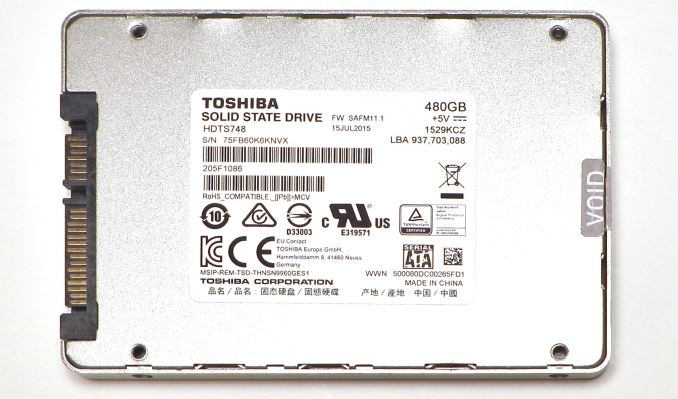The Toshiba Q300 SSD Review: Toshiba Becomes a Retail Brand
by Billy Tallis on February 26, 2016 8:00 AM ESTFinal Words
Given the strong hardware similarities to the OCZ Trion 100, I expected the Toshiba Q300 to turn in very similar benchmark scores. Instead, several noticeable differences cropped up: the Q300's latency is more variable, its active power consumption is a bit lower, and it completed The Destroyer a bit quicker. At least some of this (especially improved power efficiency) is probably due to the silicon lottery.
None of that is enough to have much effect on how it ranks. The Q300 is a low-end drive and is among the slowest SSDs on the market. It's hardly alone in that; I've lost count of how many different brands are selling Phison TLC drives. In that sense the Q300 doesn't stand out from that crowd, and while that doesn't make it a bad drive it means that Toshiba is entering a very competitive market with nothing substaintial besides their name to differentiate themselves.
With no clear price or performance advantage over even the OCZ Trion 100, the Q300 currently brings nothing new to the table. Its pricing has generally been at or above the Trion 100, so barring an unusual sale situation, there's little reason not to pick its OCZ doppelgänger. But considering the whole family of the Q300, Trion 100, and more related drives sold by other brands, the combination of Toshiba flash and Phison controller architecture has been successful at offering consumers a good budget option with no major weaknesses. Under light use, they're only slightly slower than MLC drives, rather than crippled as our most intense tests can make them look. Otherwise the SanDisk Ultra II is a better all-around performer, but at the moment only its 480GB capacity is in the lead for price.
| Value SSD Price Comparison | ||||
| Drive | 960GB | 480GB | 240GB | 120GB |
| Toshiba Q300 | $264.99 | $139.00 | $69.99 | $49.99 |
| OCZ Trion 100 | $199.99 | $129.99 | $64.98 | $54.99 |
| OCZ Trion 150 | $269.99 | $139.99 | $69.99 | $50.61 |
| ADATA SP550 | $219.99 | $119.99 | $61.99 | $39.99 |
| Crucial BX200 | $294.97 | $129.99 | $64.99 | |
| SanDisk Ultra II | $238.50 | $120.99 | $74.99 | $54.99 |
Ultimately Toshiba is in a unqiue position here that can work in their favor, even if starting things off with an entry-level drive doesn't allow them to take advantage of it. They are one of the major NAND flash manufacturers, and at the same time they have a special relationship with their controller vendor. Because of that they're not completely vertically integrated the way Samsung is, but they ought to be able to reap many of the same benefits in the long run.
From a product standpoint the Trion 100 did a good job of keeping pace with the price drops over the past several months, but neither it nor the new Q300 are sufficiently differentiated from the rest of the entry-level market. Now that Toshiba is directly participating in the retail SSD market with their own brand, I believe they should try for a unique blockbuster product to firmly establish their place. A big success like Crucial's MX100 or BX100 or Samsung's 850 Pro and EVO would make their retail venture worthwhile and could make either the OCZ or Toshiba brand a major name instead of another face in the crowd.











30 Comments
View All Comments
bill.rookard - Friday, February 26, 2016 - link
MX100's are awesome drives, I have a pair in my webserver with a M4 for the boot drive. Sadly, the whole issue appears to be (with the exception of Samsungs drives) the TLC. When having to account for the 8 different voltage states required for 3 bit per cell it seems that the controllers are not up to the task of getting things done quickly.I'm thinking widespread adoption of V-nand (regardless of manufacturer) along with MLC in a larger lithography will wind up being the perfect storm of capacity, price, speed and endurance.
Arnulf - Friday, February 26, 2016 - link
TLC cells have 8 distinct voltage levels per cell to make up for 3 bits of information, not 3.hojnikb - Friday, February 26, 2016 - link
thats what he said.kmmatney - Friday, February 26, 2016 - link
No, he said 3, not 3vladx - Friday, February 26, 2016 - link
"No, he said 3, not 3"Huh?
boozed - Friday, February 26, 2016 - link
It's really quite simple. He said 3, not 3.extide - Friday, February 26, 2016 - link
I think what we will see is 3D TLC in pretty much all mainstream stuff, and 3D MLC in the high performance stuff.Samus - Friday, February 26, 2016 - link
It's too bad the MX100 and BX100 are harder and harder to find, when the MX200 and ESPECIALLY the BX200 are inferior.leexgx - Friday, February 26, 2016 - link
the BX100 its perfect for laptops as its super power efficient, the MX100/BX100 is the most use the most power SSD (the Adata Sp550 also uses the BX200 controller)leexgx - Friday, February 26, 2016 - link
ops!! MX200/B200 or any SSD that uses TLC with SLC cache seem to be extremely high power usage, for minimal overall speed boost (and higher chance of data loss due to SLC/TLC data movement)